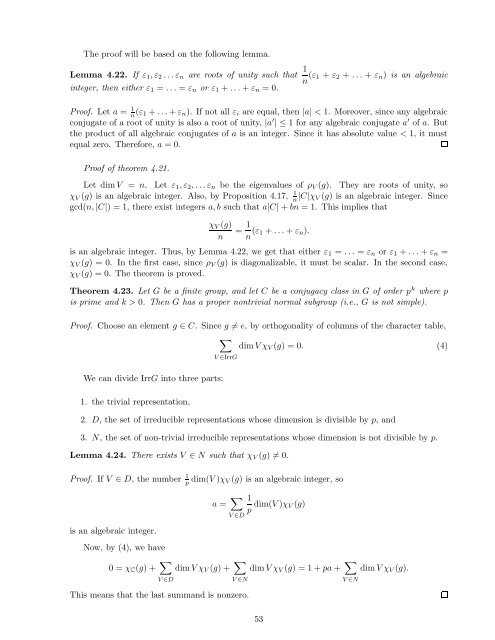Lecture notes for Introduction to Representation Theory
Lecture notes for Introduction to Representation Theory
Lecture notes for Introduction to Representation Theory
You also want an ePaper? Increase the reach of your titles
YUMPU automatically turns print PDFs into web optimized ePapers that Google loves.
The proof will be based on the following lemma.<br />
Lemma 4.22. If π 1 , π 2 . . . π n are roots of unity such that<br />
integer, then either π 1 = . . . = π n or π 1 + . . . + π n = 0.<br />
1<br />
(π 1 + π 2 + . . . + π n ) is an algebraic<br />
n<br />
Proof. Let a = 1 n<br />
(π 1 + . . . + π n ). If not all π i are equal, then | a | < 1. Moreover, since any algebraic<br />
conjugate of a root of unity is also a root of unity, | a | ∗ 1 <strong>for</strong> any algebraic conjugate a of a. But<br />
the product of all algebraic conjugates of a is an integer. Since it has absolute value < 1, it must<br />
equal zero. There<strong>for</strong>e, a = 0.<br />
Proof of theorem 4.21.<br />
Let dim V = n. Let π 1 , π 2 , . . . π n be the eigenvalues of δ V (g). They are roots of unity, so<br />
1<br />
ν V (g) is an algebraic integer. Also, by Proposition 4.17, n<br />
|C|ν V (g) is an algebraic integer. Since<br />
gcd(n, | C | ) = 1, there exist integers a, b such that a| C | + bn = 1. This implies that<br />
ν V (g) 1<br />
= (π 1 + . . . + π n ).<br />
n n<br />
is an algebraic integer. Thus, by Lemma 4.22, we get that either π 1 = . . . = π n or π 1 + . . . + π n =<br />
ν V (g) = 0. In the first case, since δ V (g) is diagonalizable, it must be scalar. In the second case,<br />
ν V (g) = 0. The theorem is proved.<br />
Theorem 4.23. Let G be a finite group, and let C be a conjugacy class in G of order p k where p<br />
is prime and k > 0. Then G has a proper nontrivial normal subgroup (i.e., G is not simple).<br />
Proof. Choose an element g C. Since g ⇒ = e, by orthogonality of columns of the character table,<br />
<br />
dim V ν V (g) = 0. (4)<br />
We can divide IrrG in<strong>to</strong> three parts:<br />
1. the trivial representation,<br />
V IrrG<br />
2. D, the set of irreducible representations whose dimension is divisible by p, and<br />
3. N, the set of non-trivial irreducible representations whose dimension is not divisible by p.<br />
Lemma 4.24. There exists V N such that ν V (g) ⇒= 0.<br />
Proof. If V D, the number 1 dim(V )ν V (g) is an algebraic integer, so<br />
p<br />
is an algebraic integer.<br />
Now, by (4), we have<br />
1<br />
a = dim(V )ν V (g)<br />
p<br />
V D<br />
0 = ν C (g) + dim V ν V (g) + dim V ν V (g) = 1 + pa + dim V ν V (g).<br />
V D V N V N<br />
This means that the last summand is nonzero.<br />
53

















